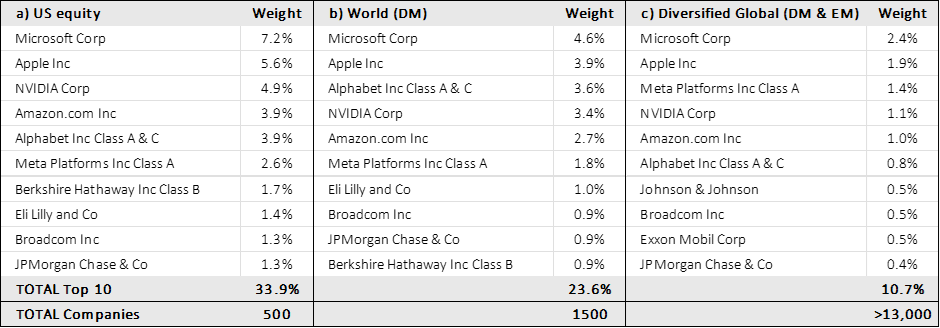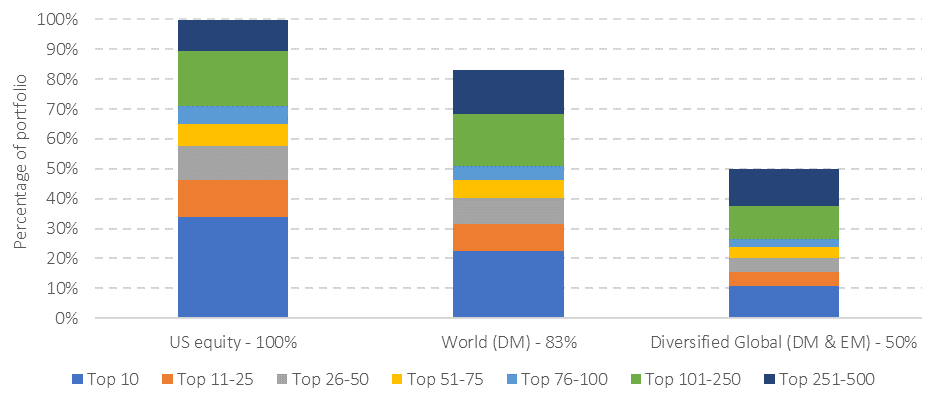Why diversification means you don't need to worry about FOMO or regret


Most investors know that in the past few years, the US market has delivered above average returns, compared to many other markets.
There's also been quite a lot written in the media lately pointing out that just a handful of stocks have driven most of the US returns.
Some return-focused investors might look at this and wonder whether they should own more in the US...
Does this sounds like you?
Is fear of missing out (FOMO) tempting you into increasing your exposure to the US or even these few specific stocks?
If so, you're likely succumbing to recency bias, where you're influenced largely by what's just happened and extrapolating this into the future.
Someone as return focused as this should, to be consistent in their logic, be eyeing the Danish stock market...
This has outperformed the US over the past 20 years, by around 5% per annum on average, driven largely by one stock – Novo Nordisk, which is 60% or the market!
If you're more risk focused...
More risk-focused investors might be becoming a bit concerned by rising company concentrations in their portfolios.
These are driven by the market capitalisation weights of individual companies, where the risk of either absolute failure or simply future underperformance isn't appealing.
Not doing something about this might become a source of both concern, and ultimately regret.
There's a simple, systematic solution to this conundrum.
Own a portfolio that's exceptionally well diversified across markets, sectors, capitalisations (mega to small companies) and tilted towards value-oriented stocks.
Looking under the bonnet using different ways of gauging diversification at the stock level, gives us insight into the portfolio construction choices on offer.
The outputs below look at the stock concentration of funds that:
- track the US equity market using the S&P 500 index;
- track the developed markets (DM) by way of the MSCI World Index and;
- provide globally-diversified exposure to developed and emerging markets (EM), with tilts towards mid-cap and smaller companies, and value stocks[1].
Table 1: Portfolio weightings of Top 10 companies compared

Source: Morningstar Direct ©
Firstly, look at the difference in the total number of stocks in each portfolio.
It's clear the US market is highly concentrated, with over a third of the market (33.9%) made up of just ten companies (left column).
Diversifying into other developed markets (middle column) improves diversification with around one quarter (23.6%) of the portfolio made up of the ten largest companies.
Diversifying into emerging markets and spreading out some of the allocation across smaller companies and value stocks (which have higher expected returns) gives significant diversification (right column).
We can take this further.
In the chart below, you can see the top 500 holdings in each of the three options.
represent from 100% of the portfolio in the case of US equities, to only 50% of the diversified global equity option.
Figure 1: Comparing how much of the portfolio the Top 500 companies represent

Source: Morningstar Direct ©
One final (and slightly more technical) measure of diversification, is the number of 'effective holdings' in the portfolio.
The calculation is based on the Herfindahl–Hirschman Index, a commonly accepted measure of market concentration, which was originally used by competition regulators to see the impact on industry concentration of mergers and acquisitions.
The 'effective' holdings show an estimate of the number of stocks that effectively represent the portfolio.
It doesn't mean the rest of the stocks are worthless and redundant.
Far from it.
Simply that they're dominated by the major stocks held.
Table 2: Effective stock holdings

Source: Morningstar Direct ©
Many investors would feel far more comfortable with 479 stocks dominating their portfolio, than just 60.
I know I do.
I know our clients do.
Diversification matters because investors own portfolios TODAY for the future, and given that markets do a pretty good job of incorporating information into prices, we have no forward-looking insight into which company’s shares are going to outperform.
No one does!
We can avoid both FOMO and regret by choosing a prudent path: maintaining ownership of a well-diversified portfolio.
[1] Funds used a) iShares Core S&P 500 ETF USD Acc b) iShares MSCI World ETF USD Dist. c) Dimensional World Equity GBP Dist. For illustration and educational purposes only. These are not recommendations of any kind.

